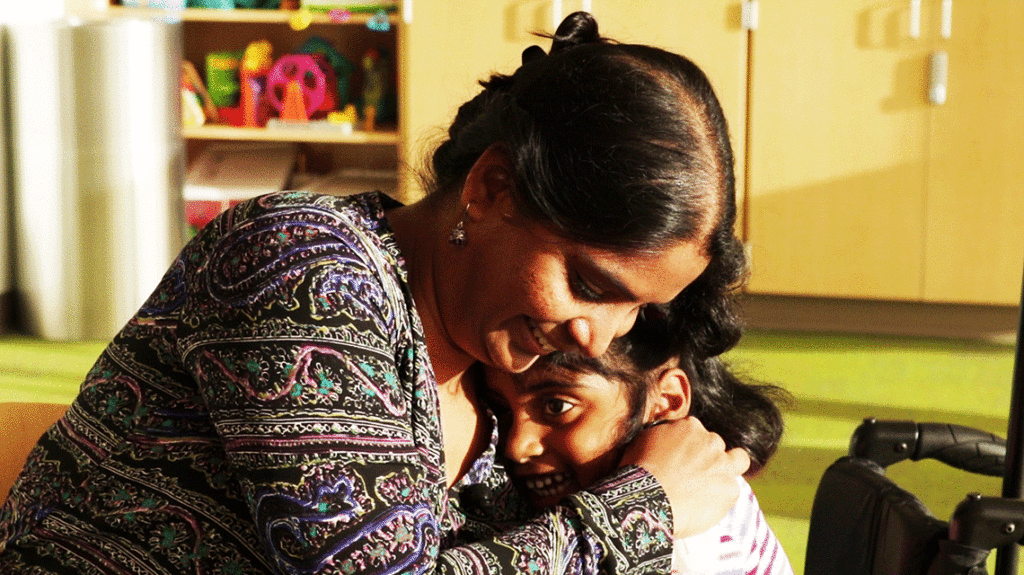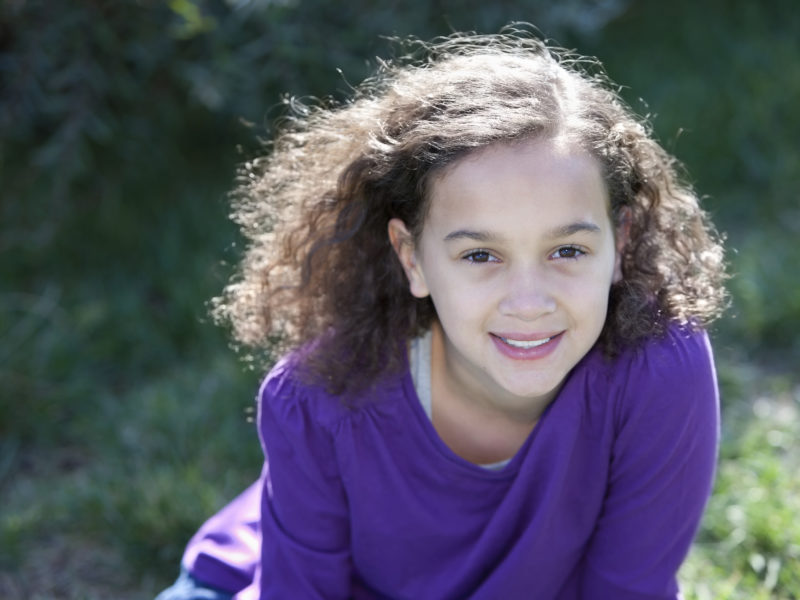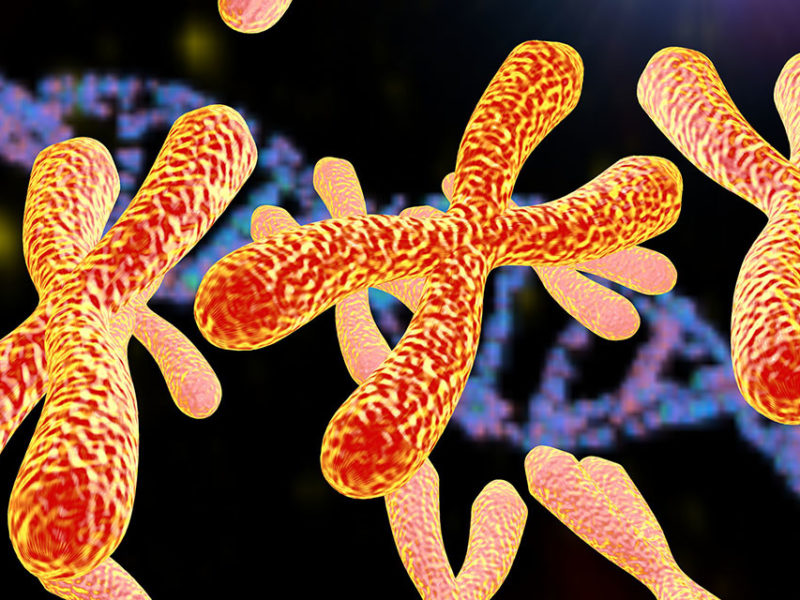Neurosurgery May Provide Lasting Relief From Spasticity
Neurosurgery May Provide Lasting Relief From Spasticity https://pediatricsnationwide.org/wp-content/uploads/2017/05/3-hug-header-1024x575.gif 1024 575 Abbie Miller Abbie Miller https://pediatricsnationwide.org/wp-content/uploads/2023/05/051023BT016-Abbie-Crop.jpg- May 30, 2017
- Abbie Miller

Selective dorsal rhizotomy can provide life-changing results, but patients work hard in physical and occupational therapy to get there.
When Sushma Manjunatha watches her daughter sleep, she sees something new. Instead of being tightly curled up, with legs pulled in, her daughter’s legs are stretched out, finally relaxed.
This change is the result of a rare neurosurgical procedure – selective dorsal rhizotomy (SDR) – performed at Nationwide Children’s Hospital.
Bhoomi Manjunathan and her twin sister were born at 30 weeks gestational age. At 6 months, Bhoomi showed developmental delays and began physical therapy; she was ultimately diagnosed with spastic cerebral palsy, specifically, spastic diplegia.
Cerebral palsy is a spectrum developmental disorder, in which patients experience a range of symptoms and developmental challenges. In Bhoomi’s case, one of the features of her cerebral palsy is that the muscles in both of her legs were spastic — that is, they had more tone than normal.
In patients with spasticity, the nerves signaling the muscles to contract are always “on.” The condition is associated with pain, limits range of motion, contributes to joint malformation and pressure ulcers, interferes with personal care and negatively impacts quality of life.
Treatments for spasticity include:
- Physical and occupational therapy
- Splinting
- Oral medications (for example, baclofen, tizanidine, diazepam)
- Botox injections to relax specific muscles
- Orthopedic surgery to address tendon shortening and joint contractures
- Intrathecal baclofen (spinal pump)
- Selective dorsal rhizotomy (SDR)
Bhoomi began physical and occupational therapy at 6 months of age. At age 2 she began walking with the aid of a wheeled walker and began receiving Botox injections to address the spasticity in her legs.
By age 5, Bhoomi’s parents began looking for more.
“Her tightness was getting in her way. The Botox wasn’t working well anymore, and we wanted to do something,” says Sushma. “We had a couple of options, but when we did the research on SDR, we found out that a lot of kids actually got to a normal life with walking and doing things for themselves.”
Selective dorsal rhizotomy (SDR) involves the removal of a portion of the spinous process and lamina to expose a portion of the dorsal nerve roots. The nerves are then tested to determine which ones are most impacting spasticity.
“We interrupt about 60 percent of the feedback circuit causing spasticity, improving their spasticity scores,” says Jeffery Leonard, MD, chief of Neurosurgery at Nationwide Children’s. “In doing this, we achieve an improvement in pain and a decrease in the number of orthopedic procedures that the patient will need in the future. SDR can provide permanent reduction of spasticity in CP, recurrence is very rare for patients with spastic diplegia.”
SDR can be performed on patients ages 4-40, though Dr. Leonard says that the ideal age is between 4 and 6 years because the patients have plateaued in their spasticity, their young age makes the procedure easier and they are old enough to participate in physical therapy.
The commitment to and partnership with physical therapy is essential to the success of SDR. Patients at Nationwide Children’s undergo two weeks of inpatient rehabilitation immediately after the surgery.
Once they go home, they have a minimum of six weeks of very intense outpatient physical and occupational therapy, says Dr. Leonard. “If you don’t perform the physical therapy, the benefits of the rhizotomy do not materialize. PT and OT are an equally important portion of what we need to do the rhizotomy.”
“It is a marathon. Bhoomi’s family understands that, and I think that they will do what is needed to accomplish the goal, which is to get her walking normally – without assistance.”
Dr. Leonard and his team are part of the Cerebral Palsy Research Network (CPRN), a research collaborative collecting data from SDR patients 6 months and one year after the procedure. Data are being collected for each of the treatment options for spasticity, but very few studies have compared those options head-to-head. The data collected as part of the collaborative will be a step toward being able to directly compare therapies and outcomes.
“We are really looking to advance what we do in this situation, and advance the science behind it,” Dr. Leonard says. “We want to really study the patients and compare them to the natural history of the disease.”
Dr. Leonard and his team are committed to offering a wide variety of therapies for the treatment of children with spasticity and other movement disorders.
“We use a multidisciplinary approach to care for each patient. In cases of SDR, the team includes physical medicine, neurology, nursing, anesthesiology, physical therapy, occupational therapy and neurosurgery,” explains Dr. Leonard. “The idea here is to come together to discuss the movement disorder, evaluate what kind of orthopedic procedures that have already been accomplished and discuss the likely outcome in each of the options. We discuss the risks of each surgical procedure and then work with the families to come up with best decision.”
For Bhoomi, the SDR was a new beginning. Through much hard work during her inpatient rehabilitation and at home, she has made incredible gains in three short months. She is gaining strength in her muscles, stands up straighter and is walking more independently with crutches. As she continues to work hard with the support of her family and medical team, her parents, doctors and therapists hope and expect her to continue making progress to her ultimate goal, walking unassisted.
About the author
Abbie (Roth) Miller, MWC, is a passionate communicator of science. As the manager, medical and science content, at Nationwide Children’s Hospital, she shares stories about innovative research and discovery with audiences ranging from parents to preeminent researchers and leaders. Before coming to Nationwide Children’s, Abbie used her communication skills to engage audiences with a wide variety of science topics. She is a Medical Writer Certified®, credentialed by the American Medical Writers Association.
-
Abbie Millerhttps://pediatricsnationwide.org/author/abbie-miller/
-
Abbie Millerhttps://pediatricsnationwide.org/author/abbie-miller/
-
Abbie Millerhttps://pediatricsnationwide.org/author/abbie-miller/
-
Abbie Millerhttps://pediatricsnationwide.org/author/abbie-miller/
- Post Tags:
- Cerebral Palsy
- Neurosurgery
- Spasticity
- Posted In:
- Clinical Updates
- Features







